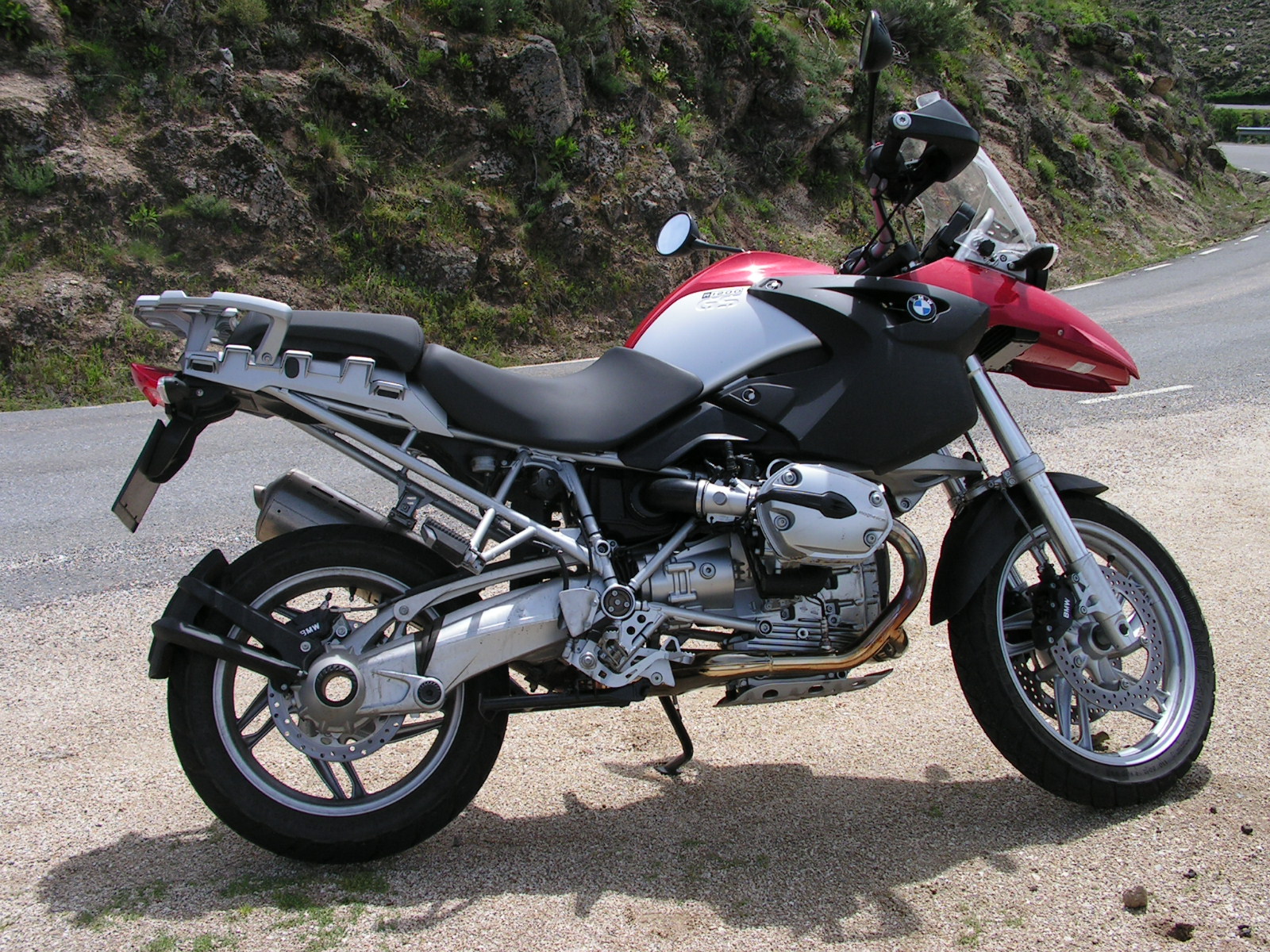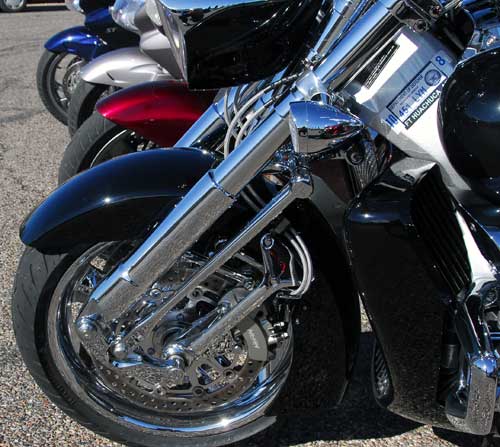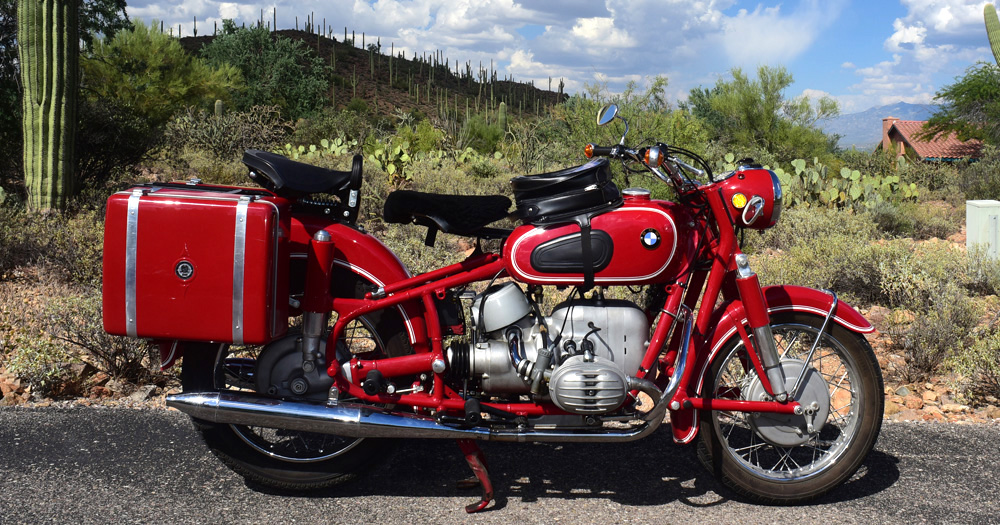|
Telelever
BMW's motorcycle history began in 1921 when the company commenced manufacturing engines for other companies. BMW's own motorcycles—sold under the BMW Motorrad brand—began in 1923 with the BMW R 32, which was powered by a flat-twin engine (also called a "boxer-twin" engine). Production of motorcycles with flat-twin engines continues to this day, however BMW has also produced many models with other types of engines. Motorcycle history 1921–1938 At the end of World War I, the Treaty of Versailles demanded that BMW cease production of aircraft engines. To remain in business, the company began producing small industrial engines (along with farm equipment, household items and railway brakes). In 1920, BMW M2B15 flat-twin petrol engine was released. Despite being designed as a portable industrial engine, the M2B15 was also used by several motorcycle manufacturers, including for the 1920–1923 Victoria KR1 and the 1920–1922 Bayerische Flugzeugwerke (BFw) ''Helios'' motorcyc ... [...More Info...] [...Related Items...] OR: [Wikipedia] [Google] [Baidu] |
BMW Motorrad
BMW Motorrad is the motorcycle brand of BMW, part of its Corporate and Brand Development division. It has produced motorcycles since 1923, and achieved record sales for the fifth year in succession in 2015. With a total of 136,963 vehicles sold in 2015, BMW registered a growth of 10.9% in sales in comparison with 2014. In May 2011, the 2,000,000th motorcycle produced by BMW Motorrad was an R1200GS. History The company began as an aircraft engine manufacturer in the early 20th century and through World War I. BMW manufactured its first motorcycle in 1923, the R32, which featured a flat-twin boxer engine. BMW Motorrad still uses the flat-twin boxer configuration, but now manufactures motorcycles with a variety of engine configurations. Current production With the exception of the G310 series (which is produced at TVS's Tamil Nadu, India plant), all BMW Motorrad's motorcycle production takes place at its plant in Berlin, Germany. Some engines are manufactured in Austria, Ch ... [...More Info...] [...Related Items...] OR: [Wikipedia] [Google] [Baidu] |
Motorcycle Fork
A motorcycle fork connects a motorcycle's front wheel and axle to its frame, typically via a yoke, also known as a triple clamp, which consists of an upper yoke joined to a lower yoke via a steering stem, a shaft that runs through the steering head, creating the steering axis. Most forks incorporate the front suspension and front brake, and allow the front wheel to rotate about the steering axis so that the bike may be steered. Most handlebars attach to the top clamp in various ways, while clip-on handlebars clamp to the fork tubes, either just above or just below the upper triple clamp. The fork and its attachment points on the frame establish the critical geometric parameters of rake and trail, which play a major role in defining how a motorcycle handles and dives during braking. While the standard telescopic fork arrangement is found with few major differences among mainstream street motorcycles since the 1970s, historically there have been many variations, including trail ... [...More Info...] [...Related Items...] OR: [Wikipedia] [Google] [Baidu] |
Motorcycle Fork
A motorcycle fork connects a motorcycle's front wheel and axle to its frame, typically via a yoke, also known as a triple clamp, which consists of an upper yoke joined to a lower yoke via a steering stem, a shaft that runs through the steering head, creating the steering axis. Most forks incorporate the front suspension and front brake, and allow the front wheel to rotate about the steering axis so that the bike may be steered. Most handlebars attach to the top clamp in various ways, while clip-on handlebars clamp to the fork tubes, either just above or just below the upper triple clamp. The fork and its attachment points on the frame establish the critical geometric parameters of rake and trail, which play a major role in defining how a motorcycle handles and dives during braking. While the standard telescopic fork arrangement is found with few major differences among mainstream street motorcycles since the 1970s, historically there have been many variations, including trail ... [...More Info...] [...Related Items...] OR: [Wikipedia] [Google] [Baidu] |
BMW R60
The R60 and R60/2 are 600 cc boxer-twin that were manufactured from 1956 to 1969 in Munich, Germany, by BMW. Production history Some 20,133 of these 600 cc shaft-drive, opposed twin R60 (1956–1960, ), R60/2 (1960–1969, ), and R60US (1968–1969, 30 hp) were built. These models, except for those with the "US" designation, were designed primarily as rugged motorcycles to pull sidecars (mounting points were built in) and had duplex tubular steel frames. Simultaneously manufactured were related models, including the 500 cc R50 (1955–1960, ), the R50/2 (1960–1969, 26 hp), the R50 S (1960–1962, ), the R50US (1968–1969, 26 hp), and the 600 cc sport-oriented R69 (1955–1960, 35 hp), R69S (1960–1969, ), and R69US (1968–1969, 42 hp). In the United States, all these Earles-fork and US-fork (i.e., telescopic fork) models from 1955 to 1969 are often lumped together as "Slash-2" BMWs, even though that is technically incorrec ... [...More Info...] [...Related Items...] OR: [Wikipedia] [Google] [Baidu] |
BMW R50
The R60 and R60/2 are 600 cc boxer-twin that were manufactured from 1956 to 1969 in Munich, Germany, by BMW. Production history Some 20,133 of these 600 cc shaft-drive, opposed twin R60 (1956–1960, ), R60/2 (1960–1969, ), and R60US (1968–1969, 30 hp) were built. These models, except for those with the "US" designation, were designed primarily as rugged motorcycles to pull sidecars (mounting points were built in) and had duplex tubular steel frames. Simultaneously manufactured were related models, including the 500 cc R50 (1955–1960, ), the R50/2 (1960–1969, 26 hp), the R50 S (1960–1962, ), the R50US (1968–1969, 26 hp), and the 600 cc sport-oriented R69 (1955–1960, 35 hp), R69S (1960–1969, ), and R69US (1968–1969, 42 hp). In the United States, all these Earles-fork and US-fork (i.e., telescopic fork) models from 1955 to 1969 are often lumped together as "Slash-2" BMWs, even though that is technically incorrec ... [...More Info...] [...Related Items...] OR: [Wikipedia] [Google] [Baidu] |
BMW R27
The 247 cc BMW R27, introduced in 1960, is a shaft-driven, single-cylinder motorcycle manufactured by BMW. History After World War II, the Potsdam Agreement of the USSR, USA, and the UK, prohibited BMW Aktiengesellschaft (AG) from building motorcycles. Later, this ban was lifted and in 1948 BMW produced its first postwar motorcycle, the 250 cc R24, which was based largely on the prewar R23. It was the only postwar BMW motorcycle produced without a rear suspension. BMW introduced the R25 model, with plunger rear suspension, in 1950. The last of the plunger models, the R25/3, was introduced in 1953. R26 In 1956 BMW introduced a completely revamped single-cylinder engine, the R26 (engine numbers 340 001 – 370 236), with improvements paralleling those introduced at the same time in the boxer twins. The R26 came with an enclosed drive shaft, rear swingarm, and front Earles forks. A new headlight nacelle came with a sliding black plastic over the ignition key, ... [...More Info...] [...Related Items...] OR: [Wikipedia] [Google] [Baidu] |
BMW R68
The BMW R68 is a sport version of the pre-1955 BMW motorcycles. A total of 1,452 models were manufactured from 1952 to 1954,Preston making it one of BMW's rarest production motorcycles.Falloon pp: 8–13 History In October 1951, at the German International Motorcycle Show in Frankfurt, BMW displayed a new high performance model.Walker The machine had improved performance of compared to the low-compression R67/2, a racing-type magneto, bigger bore 26 mm Bing carburetors and improved twin leading-shoe front brake. It also came with a more modern sporty narrow front fender rather than the deeply valanced fender used on other BMW twins. BMW announced the R68 as "The first 100 mph motorcycle." It was shown as a road bike, capable of , with normal two low exhaust silencers, and an off-road version with a single high silencer. A separate pillion pad resembled a passenger saddle, but was provided for the rider to slide backward in order to crouch low for higher speeds. For th ... [...More Info...] [...Related Items...] OR: [Wikipedia] [Google] [Baidu] |
90 Years Of Motorcycling Excellence
9 (nine) is the natural number following and preceding . Evolution of the Arabic digit In the beginning, various Indians wrote a digit 9 similar in shape to the modern closing question mark without the bottom dot. The Kshatrapa, Andhra and Gupta started curving the bottom vertical line coming up with a -look-alike. The Nagari continued the bottom stroke to make a circle and enclose the 3-look-alike, in much the same way that the sign @ encircles a lowercase ''a''. As time went on, the enclosing circle became bigger and its line continued beyond the circle downwards, as the 3-look-alike became smaller. Soon, all that was left of the 3-look-alike was a squiggle. The Arabs simply connected that squiggle to the downward stroke at the middle and subsequent European change was purely cosmetic. While the shape of the glyph for the digit 9 has an ascender in most modern typefaces, in typefaces with text figures the character usually has a descender, as, for example, in . The mod ... [...More Info...] [...Related Items...] OR: [Wikipedia] [Google] [Baidu] |
West Germany
West Germany is the colloquial term used to indicate the Federal Republic of Germany (FRG; german: Bundesrepublik Deutschland , BRD) between its formation on 23 May 1949 and the German reunification through the accession of East Germany on 3 October 1990. During the Cold War, the western portion of Germany and the associated territory of West Berlin were parts of the Western Bloc. West Germany was formed as a political entity during the Allied occupation of Germany after World War II, established from eleven states of Germany, states formed in the three Allied zones of occupation held by the United States, the United Kingdom, and France. The FRG's provisional capital was the city of Bonn, and the Cold War era country is retrospectively designated as the Bonn Republic. At the onset of the Cold War, Europe was divided between the Western and Eastern Bloc, Eastern blocs. Germany was divided into the two countries. Initially, West Germany claimed an exclusive mandate for all of Ger ... [...More Info...] [...Related Items...] OR: [Wikipedia] [Google] [Baidu] |
Eisenacher Motorenwerk
Eisenacher Motorenwerk (EMW) was an East German manufacturer of automobiles and motorcycles based in Eisenach. EMW also entered Formula One as a constructor in 1953, but participated in only one race, the 1953 German Grand Prix. The car retired after 12 laps with exhaust problems. Continuing BMW production One of the pre-World War II BMW factories was located in Eisenach, which after the war was taken over by the Soviets, since Eisenach was situated in the Soviet occupation zone. The factory continued producing cars and motorcycles under the BMW brand, but after a lawsuit in 1952 they had to change the name to EMW instead. The logotype was also similar, but instead of the blue BMW used, EMW used red. The Kasernierte Volkspolizei (a paramilitary police branch which preceded the National People's Army) and the succeeding East German armed forces needed vehicles and expressed interest in reviving production of the BMW 325, an unsuccessful wartime off-road ''Einheits-PKW'' (stand ... [...More Info...] [...Related Items...] OR: [Wikipedia] [Google] [Baidu] |
War Reparations
War reparations are compensation payments made after a war by one side to the other. They are intended to cover damage or injury inflicted during a war. History Making one party pay a war indemnity is a common practice with a long history. Rome imposed large indemnities on Carthage after the First (Treaty of Lutatius) and Second Punic Wars. Some war reparations induced changes in monetary policy. For example, the French payment following the Franco-Prussian war played a major role in Germany's decision to adopt the gold standard; the 230 million silver taels in reparations imposed on defeated China after the First Sino-Japanese War led Japan to a similar decision. There have been attempts to codify reparations both in the Statutes of the International Criminal Court and the UN Basic Principles on the Right to a Remedy and Reparation for Victims, and some scholars have argued that individuals should have a right to seek compensation for wrongs they sustained during warfar ... [...More Info...] [...Related Items...] OR: [Wikipedia] [Google] [Baidu] |









